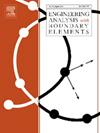Naturally stabilized nodal integration of Chebyshev moving Kriging meshless approach for functionally graded triply periodic minimal surface plates
IF 4.1
2区 工程技术
Q1 ENGINEERING, MULTIDISCIPLINARY
Engineering Analysis with Boundary Elements
Pub Date : 2025-06-14
DOI:10.1016/j.enganabound.2025.106333
引用次数: 0
Abstract
This study introduces a novel model employing Chebyshev polynomials for both shear deformation theory and moving Kriging meshless method for computationally efficient analysis of functionally graded triply periodic minimal surface (FG-TPMS) plates. The introduction of a naturally stabilized nodal integration (NSNI) scheme significantly enhances the computational efficiency of the proposed numerical approach and guarantees a numerically stable solution, outperforming traditional methods that employ the Gaussian quadrature (GI) rule. In addition, the FG-TPMS plates are designed based on porous structures of Primitive (P), Gyroid (G) and Wrapped Package-Graph (IWP) types, each analyzed under six volume distribution cases. Mechanical properties are determined through a two-phase piecewise fitting technique. The proposed numerical approach is employed to solve the governing equations, which are derived based on the virtual work principle. Validated through parameter studies, this combined approach demonstrates efficiency and accuracy in predicting the transverse deflection and natural frequency for various geometries, volume distributions, aspect ratio, and boundary conditions. The proposed NSNI method consistently outperforms GI in terms of computational time, with numerical results showing that GI often takes more than four times longer to compute. For that reason, the proposed methodology provides a robust solution for analyzing FG-TPMS plates and advances computational methods for complex structures.
切比雪夫移动Kriging无网格法求解功能梯度三周期最小面板的自然稳定节点积分
针对功能梯度三周期最小表面(FG-TPMS)板,提出了一种基于切比雪夫多项式的剪切变形理论和移动Kriging无网格法的新模型。引入自然稳定节点积分(NSNI)方案大大提高了所提出的数值方法的计算效率,并保证了数值稳定的解决方案,优于采用高斯正交(GI)规则的传统方法。此外,FG-TPMS板的设计基于原始(P),陀螺(G)和包裹封装图(IWP)类型的多孔结构,并在六种体积分布情况下对每种结构进行了分析。力学性能通过两相分段拟合技术确定。根据虚功原理推导出控制方程,并采用数值方法求解控制方程。通过参数研究验证,该组合方法在预测各种几何形状、体积分布、纵横比和边界条件下的横向挠度和固有频率方面具有效率和准确性。所提出的NSNI方法在计算时间方面始终优于GI,数值结果表明GI的计算时间通常是GI的四倍以上。因此,所提出的方法为分析FG-TPMS板提供了一个强大的解决方案,并推进了复杂结构的计算方法。
本文章由计算机程序翻译,如有差异,请以英文原文为准。
求助全文
约1分钟内获得全文
求助全文
来源期刊

Engineering Analysis with Boundary Elements
工程技术-工程:综合
CiteScore
5.50
自引率
18.20%
发文量
368
审稿时长
56 days
期刊介绍:
This journal is specifically dedicated to the dissemination of the latest developments of new engineering analysis techniques using boundary elements and other mesh reduction methods.
Boundary element (BEM) and mesh reduction methods (MRM) are very active areas of research with the techniques being applied to solve increasingly complex problems. The journal stresses the importance of these applications as well as their computational aspects, reliability and robustness.
The main criteria for publication will be the originality of the work being reported, its potential usefulness and applications of the methods to new fields.
In addition to regular issues, the journal publishes a series of special issues dealing with specific areas of current research.
The journal has, for many years, provided a channel of communication between academics and industrial researchers working in mesh reduction methods
Fields Covered:
• Boundary Element Methods (BEM)
• Mesh Reduction Methods (MRM)
• Meshless Methods
• Integral Equations
• Applications of BEM/MRM in Engineering
• Numerical Methods related to BEM/MRM
• Computational Techniques
• Combination of Different Methods
• Advanced Formulations.
 求助内容:
求助内容: 应助结果提醒方式:
应助结果提醒方式:


